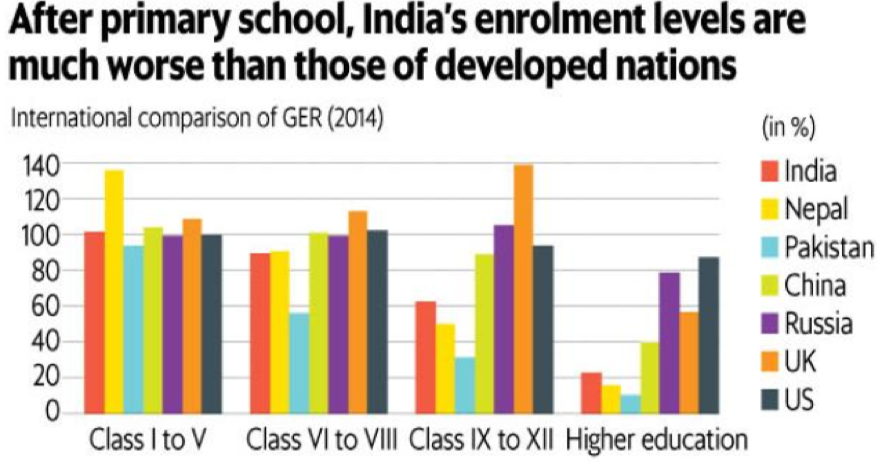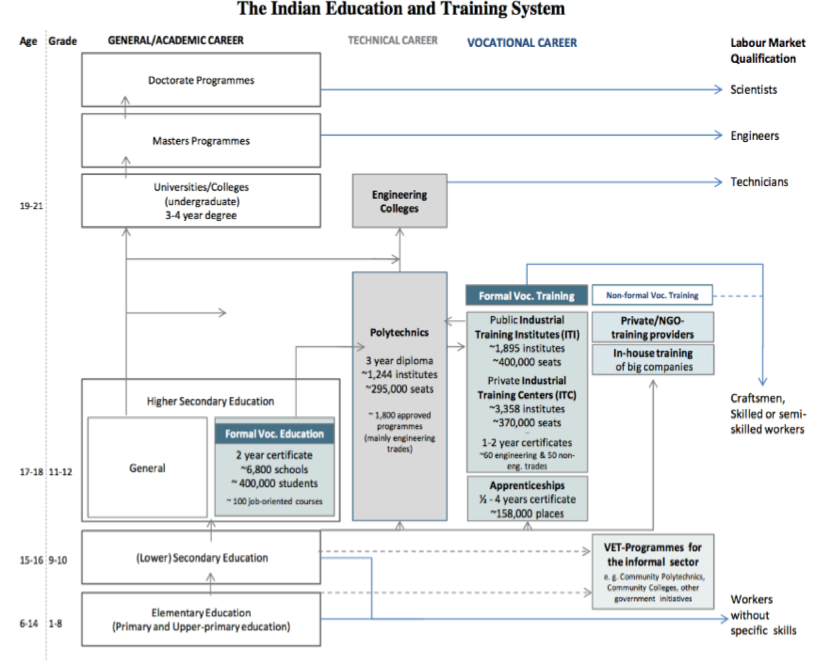Against the backdrop of a severe skills shortage in the country and millions of youth unemployed or unemployable, India’s Technical and Vocational Education and Training (TVET) system can do with some rework.
Today’s topic is part of our theme on creating robust training ecosystems. Read our previous blog post ‘Giving Skill Building a Shot in the Arm’
An estimated 3.5 lakh engineers and 2.5 million university graduates come out of the higher education system each year, with an estimated 5 million graduates out of work at any given point. Moreover, A FICCI-Ernst & Young (2012) report on skill development had forecast 50–70 million new jobs up to 2017-18, of which 75%–90% would require some form of TVET education.
Union Minister Anantkumar Hegde earlier this year called ‘unemployability’ the biggest challenge that could constrain India’s growth. The current system is not fully kitted out to respond to requirements of the labour market. Skills of youth even with higher degrees are mismatched with demands from industry.
Education Predicament
Universal enrolment rate in India at the primary level (class I-V) is on par with developed countries, with around 100% enrolment in class I-V in 2014-15. However, after class VI things change. In higher education, India’s enrolment rate stands at 23%, as against about 87% in the US, 57% in the UK and 39% in China.[i]


Dropout rate from formal education peaks at the secondary level (class IX-X at 17%, as compared to 4% in elementary school (class I-VIII) and 2% in upper secondary school (class XI-XII).[ii]
It is quite disturbing if years of schooling and education are unable to produce work ready youth. Where will millions of young people end up?
Vocational training in India is split into two forms- formal and non- formal.[iii] The former is a structured training program leading to qualifications recognised by public and private sector employers. Much of the formal skills training is imparted through Industrial Training Institutes (ITIs) and Industrial Training Centers (ITCs) under the Ministry of Labor and Employment. Non-formal vocational training on the other hand follows no standard curriculum, assessment or qualification and is completely outside the remit of the education system. It is casual, which may equip a young person with some skill to carry on an ancestral trade or occupation, such as in agriculture or traditional crafts. According to the Annual Skill Report 2016-17 a dismal 4.69% of India’s workforce has formal vocational skills, as against 60%- 90% in developed countries.
Let’s look at the current framework of general and VET education in India with an aim to draw out possible ways to strengthen it.


To participate in vocational training a young person must have completed 8-10 years in education. Moreover, most apprenticeship posts in Indian industry and PSUs ask for minimum eight years of education plus one to three years of formal vocational training from an ITI or ITC. However, as dropout rate from formal education in India peaks at the secondary level (class IX-X) youth who have got to this stage and are disenfranchised from the traditional schooling route with zero exposure to vocational education are left out in the cold. Hence this is a case of a serious lost opportunity where the young are leaving school with no qualifications and no skills. Increasing enrolment in lower secondary education by providing clear alternative pathways for school to work transition is an urgent need to tackle the issue of drop-outs and must form an integral part of the country’s education policies.
Lower entry point- A way around would be to lower the entry point to vocational training for youth who have not completed secondary education, and offer more courses with lower levels of educational attainment. For instance in Germany, after four years of elementary school students have a choice within the three-tier school system: 1) general education leading to a university degree 2) A middle school curriculum leading to certification in broad based education and vocational preparation qualifications 3) secondary school which is a customised educational programme for students with practical skills or interests which introduces real world working.
German Dual System- This refers to integrating school-based learning with work-based practice, the bedrock of Germany’s educational system renowned for churning out highly skilled workers. The vocational track allows students to enter vocational training in full time schools or within the framework of the dual system. Over 50 percent of Germans enter dual vocational and educational training programs which is widely cited as boosting Germany’s export strength.
Especially noteworthy are two vocational routes designed for young people from economically backward backgrounds, with learning difficulties or the physically handicapped. These are offered via a pre-vocational one-year course of training usually offered full-time by schools to prepare young people for further demands of vocational training. Entrants to this route do not have a secondary school certificate which can be acquired in the course of the pre-vocational training year thus improving their prospects for enhanced training.
Another route is the “Vocational Qualification Prospects” programme which in essence offers second-chance qualifications for young adults without a secondary school qualification or for semiskilled and unskilled young adults from German as well as migrant backgrounds.
It therefore comes as no surprise that when children as young as elementary school are exposed to notions of real world work based education Germany can boast of the lowest unemployment rates for youth in the EU. In December 2016, the unemployment rate for 15-24-year olds in Germany was 6.7% compared with 17.3% across other EU states.
Indian Dual System
In an extremely positive development the Ministry of Skill Development & Entrepreneurship (MSDE) introduced a ‘Dual System of Training’ from August, 2016. The primary objective is to improve linkages between industry and ITIs. Under this system the private sector is able to partner with state and private ITIs to offer training in high employability courses. ITIs are required to sign MoUs with industry employers where trainees would go for practical training. The industry partner must be a registered MSME and above. According to the Directorate General of Training website (accessed 31.10.10) 119 MoUs had been signed under the dual system with Odisha, UP and Rajasthan topping the list. It is worth mentioning that 16 popular trades come under the dual system of which the minimum qualification criterion in all except one trade is Grade 10. As suggested above, lowering the entry point for participation in skills based training may be a way to catch vast number of youth who drop out at the secondary education stage.
Integration with Higher Education with NSQF
Unlike other countries with a more developed VET system (UK, Australia, Germany), in India the vocational and higher education sectors have historically been almost mutually exclusive with little room for mobility from the vocational to the higher education sector forcing students to be in one or the other and transferring between the two streams is also not easy.
In line with countries which allow transfer of credits from vocational education to mainstream education and back, the government in 2013 approved the National Skills Qualifications Framework (NSQF). The NSQF is a quality assurance framework which offers qualifications on a graded system (levels 1-10) of knowledge, skills and aptitude. These levels apply to formal and non-formal training thus aiming to bring about harmonisation and standardisation of skills. Come 27.12.2018[iv] it will become mandatory for all training and educational programmes to be NSQF-compliant.
However, recent criticism points to a chasm between the understanding and implementation of NSQF. The NSQF requires close coordination between curriculum developers, trainers, trainees and industry at each competency level to establish key skills at the different stages of attainment. Additionally, certification by different awarding bodies should carry the same credibility which can be achieved by making available NSQF approved Qualification Packs (QPs) and National Occupational Standards (NOS) to avoid duplication of similar qualifications.
Vocationalisation of Education
‘Vocationalisation of Secondary and Higher Secondary Education’ is a centrally sponsored scheme to implement vocational education in government secondary and higher secondary schools. The scheme aims to enhance employability of youth ‘through competency based modular vocational courses; to maintain their competitiveness through provisions of multi-entry multi-exit learning opportunities and vertical mobility; to fill the gap between the educated and the employable; and to decrease pressure on academic higher education.’[v]
More recently, the ministry of HRD launched a new scheme called ‘Samagra Shiksha Abhiyan’ (Holistic Education for Holistic Development) where vocationalisation of education will be one of its key features from pre-school to class 12.
Another route is the UGC’s Bachelor of Vocational (BVoc) degrees with multiple entry-exit points such as Diplomas & Advanced Diplomas under the NSQF framework. In 2015-16,162 universities and colleges were approved under the scheme.
In conclusion, notwithstanding several schemes and initiatives to strengthen the presence of TVET in mainstream education, the absence of clear data and a somewhat disjointed implementation make it difficult to gauge their impact. Where weaknesses have been found a unified effort is required to simplify the processes. A robust vetting and monitoring system for VET in India is crucial. Given the severe skill crunch and high youth unemployment facing the country the value of vocational education in mainstream education becomes indisputable and should become a matter of national priority.
References
[i] Trends in school enrolment and dropout levels, Oct 02 2017, LiveMint
[ii] Educational Statistics At a Glance, 2018, Department of School Education & Literacy, MoHRD
[iii] Status Of Education And Vocational Training In India 2004-2005, Ministry of Statistics and Programme Implementation, National Sample Survey Organization (NSSO)
[iv] NSQF Gazette Notification, Ministry of Skill Development & Entrepreneurship
[v] Approval for the revised scheme of “Vocationalisation of Secondary and Higher Secondary Education”, 12 Feb 2014, Press Information Bureau














